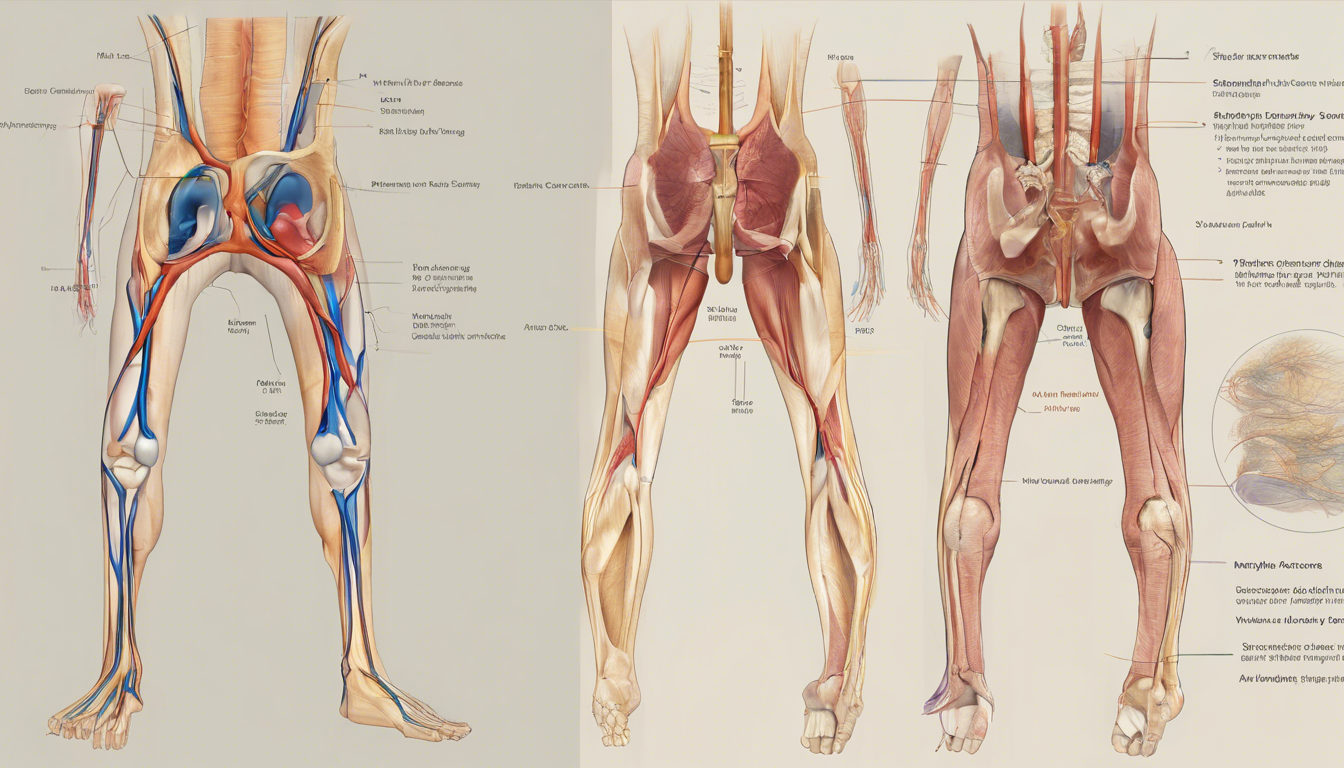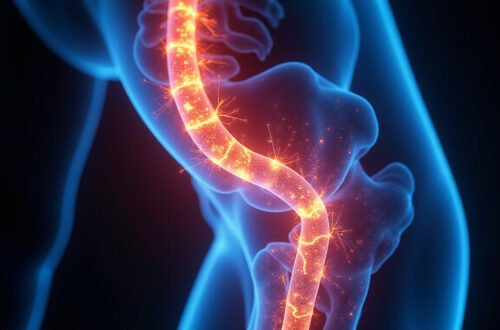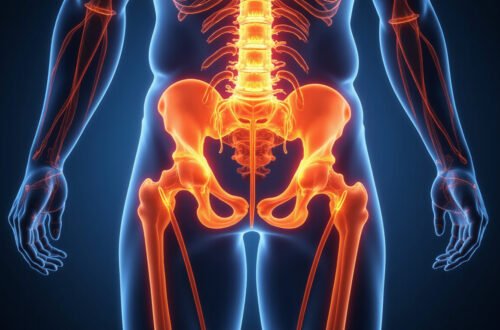Understanding the sciatic nerve anatomy is crucial for anyone experiencing lower back pain or sciatica.
This comprehensive guide aims to unravel the complexities of the sciatic nerve, its structure, functions, and the common disorders associated with it.
By the end of this article, you’ll not only have a solid grasp of what the sciatic nerve is but also how it impacts everyday movement and functionality.
Whether you’re a healthcare professional, a student of anatomy, or simply curious about your body’s physiology, this guide will provide you with valuable insights into the fascinating world of sciatic nerve anatomy.
Your Sciatica Pain-Free Future Starts Here – Click to Learn More!
Key Takeaways
- The sciatic nerve is the largest nerve in the body and plays a crucial role in leg movement and sensation.
- Understanding the structure of the sciatic nerve can help identify various health issues related to its anatomy.
- Common disorders involving the sciatic nerve include sciatica, herniated discs, and piriformis syndrome.
- Various diagnostic techniques, such as MRI and electromyography, are used to evaluate sciatic nerve problems.
- Treatment options for sciatic nerve conditions range from physical therapy to surgical interventions.
Introduction to Sciatic Nerve Anatomy
The sciatic nerve anatomy is a fascinating aspect of the human nervous system, especially considering its vital role in locomotion and sensation.
Originating from the lumbar and sacral spinal nerves, the sciatic nerve is the largest nerve in the body, measuring up to an entire inch in diameter.
It branches off into the tibial and common peroneal nerves, which extend down the leg to facilitate movement and sensory perception.
Understanding the intricate sciatic nerve anatomy not only helps in diagnosing and treating conditions like sciatica, but it also highlights the complexity of how our bodies enable movement and respond to stimuli.
The Structure of the Sciatic Nerve
Understanding the sciatic nerve anatomy is crucial for anyone looking to grasp how this important nerve functions within the body.
The sciatic nerve, the largest nerve in the human body, originates from the lower spine and stretches down through the buttock, branching into the leg and foot.
It is primarily composed of nerve roots from the lumbar and sacral spine segments, specifically L4, L5, S1, S2, and S3.
The anatomy of the sciatic nerve can be further divided into two major branches: the tibial nerve and the common peroneal (or fibular) nerve.
These branches play vital roles in motor and sensory functions in the legs, making a comprehensive understanding of sciatic nerve anatomy essential for diagnosing and treating conditions like sciatica, which causes pain that radiates along the path of the nerve.
‘The body is a sacred garment.’ – Martha Graham
Functions of the Sciatic Nerve in the Body
The sciatic nerve is one of the most significant nerves in the human body, playing a crucial role in both movement and sensation.
Understanding the sciatic nerve anatomy is vital for recognizing its functions and the implications of injuries or disorders affecting it.
The sciatic nerve originates from the lower back, specifically from the lumbar and sacral plexus, and travels down through the buttocks and into the legs.
Its primary functions include providing motor control to various muscles in the lower limbs, as well as sensory information from the skin of the legs and feet.
In essence, the sciatic nerve facilitates actions such as walking, running, and even sitting comfortably, by ensuring that messages between the brain and lower body are transmitted efficiently.
Therefore, a clear grasp of sciatic nerve anatomy not only enhances our understanding of human physiology but also emphasizes the importance of maintaining its health to prevent conditions like sciatica, which can severely impact quality of life.
Your Sciatica Pain-Free Future Starts Here – Click to Learn More!
Common Disorders Related to Sciatic Nerve Anatomy
Understanding the sciatic nerve anatomy is crucial as it plays a significant role in various common disorders that can affect mobility and comfort.
The sciatic nerve is the longest nerve in the human body, running from the lower back through the hips and buttocks and down each leg.
Disorders such as sciatica, characterized by pain radiating along the path of the nerve, often stem from issues like herniated discs or spinal stenosis compressing the nerve roots.
Additionally, conditions like piriformis syndrome occur when the piriformis muscle irritates the sciatic nerve, leading to pain, tingling, or numbness in the affected leg.
Understanding these common disorders related to sciatic nerve anatomy not only aids in early diagnosis but also enhances treatment approaches and preventive measures, ensuring better quality of life for those affected.
Diagnostic Techniques for Sciatic Nerve Issues
Understanding the sciatic nerve anatomy is crucial for diagnosing various conditions that may lead to sciatic nerve issues.
The sciatic nerve, the largest nerve in the body, runs from the lower back through the hips and buttocks and down each leg.
When patients present with symptoms like pain, tingling, or weakness in the legs, healthcare providers often utilize several diagnostic techniques to pinpoint the problem.
These may include physical examinations, where physicians assess range of motion and reflexes, and imaging tests such as MRI or CT scans that provide detailed views of the spine and surrounding structures.
Electromyography (EMG) and nerve conduction studies are also employed to evaluate the nerve’s efficiency and health.
By integrating knowledge of the sciatic nerve anatomy with these diagnostic methods, professionals can effectively identify the underlying issues and create an appropriate treatment plan.
FAQs
What is the sciatic nerve and why is it important?
The sciatic nerve is the largest nerve in the human body, extending from the lower back down through the buttocks and into the legs.
It plays a crucial role in connecting the spinal cord to the legs and feet, facilitating movement and sensation.
What are the common symptoms of sciatic nerve issues?
Common symptoms of sciatic nerve problems include pain that radiates from the lower back into the leg, tingling or numbness in the legs or feet, and weakness in the affected limb.
What are some disorders related to the sciatic nerve anatomy?
Common disorders include sciatica, herniated discs, spinal stenosis, and piriformis syndrome, all of which can lead to pain and discomfort along the path of the sciatic nerve.
How can doctors diagnose sciatic nerve issues?
Doctors may use a combination of physical examinations, patient history, imaging tests like MRI or CT scans, and nerve conduction studies to diagnose issues related to the sciatic nerve.
What treatment options are available for sciatic nerve conditions?
Treatment options vary and may include physical therapy, medications for pain relief, corticosteroid injections, and in severe cases, surgical interventions.






